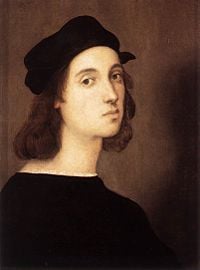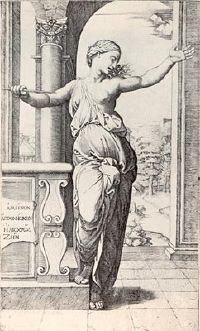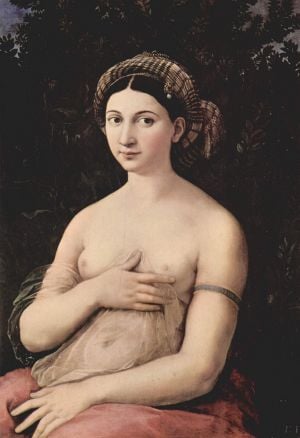Raphael
| Raphael | |
 Self-portrait by Raphael | |
| Birth name | Raffaello Sanzio |
| Born | April 6, 1483 Urbino, Italy |
| Died | April 6, 1520 |
| Nationality | Italian |
| Field | Painting |
| Training | Perugino |
| Movement | Renaissance |
Raphael or Raffaello (April 6, 1483 – April 6, 1520) was an Italian master painter and architect of the Florentine school in High Renaissance, celebrated for the perfection and grace of his paintings. He is most well known for his Madonnas and for his work in the Vatican. He was also called Raffaello Sanzio, Raffaello Santi, Raffaello da Urbino or Rafael Sanzio da Urbino.
Early life and work
Raphael (his baptismal name) was born in Urbino. The surname Sanzio derives from the latinization of the Italian, Santi, into Santius. His father, Giovanni Santi, was a lesser painter in the court of Urbino.
When Raphael was eight years old, in 1491, his mother Màgia died; his father then died on August 1, 1494, having already remarried. Thus orphaned at eleven, Raphael was entrusted to his uncle Bartolomeo, a priest. He had already shown artistic talent, according to Giorgio Vasari, who tells that since childhood Raphael had been "a great help to his father." His father's workshop continued and probably together with his stepmother, Raphael evidently played a part in managing it. He is described as a "master" at eighteen years of age in 1501. In Urbino, he came into contact with the works of Uccello and Signorelli. According to Vasari, his father placed him in Perugino's workshop as an apprentice "despite the tears of his mother," from around 1500.
His first documented work was an altarpiece for the church of San Nicola of Tolentino in Città di Castello, a town halfway between Perugia and Urbino. It was ordered in 1500 and finished in 1501 (it was later seriously damaged during an earthquake in 1789 and today only fragments of it remain). In the following years he painted works for other churches there, like the Wedding of the Virgin, (today in the Brera) and for Perugia.
Florence
In 1504 he went to Florence, where he studied the work of Leonardo da Vinci and Michelangelo. He spent almost four years there (the so-called "Florentine period"), but continued to travel to and work in other places (Perugia, Urbino and perhaps also Rome). He made friends with the local painters, particularly Fra Bartolomeo, who influenced him to discard the thin, graceful style of Perugino for more grandiose and powerful forms.
Rome
At the end of 1508, he moved to Rome and was immediately commissioned by Julius II to paint some of the rooms at his palace at the Vatican. This marked a turning point - he was only twenty-five years old, an artist in formation, and had not received commissions of such importance and prestige. He well exploited the situation, and remained almost exclusively in the service of Julius and his successor Leo X.
In 1514 he was named architect of the new St Peter's. Much of his work there was altered or demolished after his death, but he designed other buildings, and for a short time was both the most important architect and painter in Rome. In 1515 he was entrusted with the preservation and recording of the Vatican collections of ancient sculpture.
After his arrival in Rome, he devoted his efforts to the great Vatican projects, although he still painted portraits of his two main patrons, the popes Julius II and his successor Leo X, the latter portrait considered one of his finest.
One of his most important papal commissions was the Raphael Cartoons (now Victoria and Albert Museum), a series of 10 cartoons for tapestries with scenes of the lives of Saint Paul and Saint Peter, intended as wall decoration for the Sistine Chapel. The cartoons were sent to Bruxelles to be sewn in the workshop of Pier van Aelst; the first three tapestries were sent to Rome in 1519. It is possible that Raphael saw the finished series before his death—they were completed in 1520 for Leo X.
Raphael, who in Rome lived in Borgo, never married, but it appears that in 1514 he was engaged to Maria Bibbiena (a cardinal's granddaughter); she died in 1520. The other woman in his life was La Fornarina, a beauty named Margherita, the daughter of a baker (fornaro) named Francesco Luti from Siena who lived at via del Governo Vecchio.
According to Vasari, his premature death on Good Friday (April 6, 1520) was caused by a night of excessive sex with her, after which he fell into a fever and, not telling his doctors that this was its cause, was given the wrong cure, which killed him. Whatever the cause, in his acute illness Raphael had the wit to receive the last rites, and put his affairs in order. He took the care to dictate his will, in which he left sufficient funds for her care, entrusted to his loyal servant Bavera. Vasari underlines that Raphael was also born on a Good Friday, in 1483, on the 27th or 28th of March.
At his request, he was buried in the Pantheon. Raphael died on his 37th birthday, with his funeral mass celebrated at the Vatican, and his “Transfiguration” placed at the head of the bier.
Printmaking
Raphael made no prints himself, but entered into a collaboration with Marcantonio Raimondi to produce engravings to Raphael's designs, which created many of the most famous Italian prints of the century, and was important in the rise of the reproductive print. A total of about 50 prints were made; some were copies of Raphael's paintings, but other designs were apparently created only to be made into prints. Raphael made preparatory drawings, many of which survive, for Raimondi to translate into engraving. The two most famous original prints to result from the collaboration were Lucretia and The Massacre of the Innocents. Outside Italy, reproductive prints by Raimondi and others were the main way that Raphael's art was experienced until the twentieth century.
Legacy
The inscription in his marble sarcophagus, a distichon written by Pietro Bembo, reads: "Ille hic est Raffael, timuit quo sospite vinci, rerum magna parens et moriente mori." Meaning (according to the sign beside it): "Here lies Raffaello who, when alive, Nature was afraid to be won by him, when he died, she wanted to die herself."
Raphael was highly admired by his contemporaries. When compared to Michelangelo and Titian, he was sometimes considered inferior; at the same time, it was maintained that none of them shared all the qualities possessed by Raphael, "ease" in particular.
"While we may term other works paintings, those of Raphael are living things; the flesh palpitates, the breath comes and goes, every organ lives, life pulsates everywhere." - Vasari, Lives of the Artists
Chronology of main works
Early works
- Angel (fragment of the Baronci Altarpiece) (1500-1501) - Oil on wood, 31 x 27 cm, Pinacoteca Civica Tosio Martinengo, Brescia, Italy
- Angel (fragment of the Baronci Altarpiece) (1500-1501) - Oil on wood, 57 x 36 cm, Louvre, Paris
- St. Sebastian (1501-1502) - Oil on wood, 43 x 34 cm, Accademia Carrara, Bergamo
- The Crowning of the Virgin (Oddi Altar) (c. 1501-1503) - Oil on canvas, 267 x 163 cm, Pinacoteca Vaticana, Vatican, Rome
- The Annunciation (Oddi Altar, predella) (c. 1501-1503) - Oil on canvas, 27 x 50 cm, Pinacoteca Vaticana, Vatican, Rome
- The Adoration of the Magi (Oddi Altar) (c. 1501-1503) - Oil on canvas, 27 x 150 cm, Pinacoteca Vaticana, Vatican, Rome
- The Presentation in the Temple (Oddi Altar, predella) (c. 1501-1503) - Oil on canvas, 27 x 50 cm, Pinacoteca Vaticana, Vatican, Rome
- Portrait of a Man - Oil on wood, 45 x 31 cm, Galleria Borghese, Rome
- Madonna Solly (Madonna with the Child) (1500-1504) - Oil on tablet, 53 x 38 cm, Gemäldegalerie, Berlin
- Mond Crucifixion (Città di Castello Altarpiece) (1501-1503) - Oil on wood, 281 x 165 cm, National Gallery, London
- Three Graces (c. 1501-1505) - Musée Condé, Chantilly, France
- St. Michael (c. 1501) - Louvre, Paris
- Connestabile Madonna (1502-1503) - Tempera on wood, 17,5 x 18 cm, The Hermitage, St. Petersburg
- Madonna and Child (1503) - Oil on wood, 55 x 40 cm, Norton Simon Museum of Art, Pasadena
- The Marriage of the Virgin (1504) - Oil on roundheaded panel, 174 x 121 cm, Pinacoteca di Brera, Milan
- Vision of a Knight (1504) - Egg tempera on poplar, 17.1 x 17.1 cm, National Gallery, London
- St. George (1504) - Oil on tablet, 31 x 27 cm, Louvre, Paris
- Madonna and Child Enthroned with Saints (Colonna Altarpiece), (1504-1505) - Tempera and gold on wood, 172,4 x 172,4 cm (main panel), Metropolitan Museum of Art, New York
- Portrait of Perugino (c. 1504) - Tempera on wood, 57 x 42 cm, Uffizi, Florence
Florentine period
- Portrait of Elisabetta Gonzaga (c. 1504) - Oil on wood, 52,9 x 37,4 cm, Uffizi, Florence
- Portrait of Pietro Bembo (c. 1504) - Oil on wood, 54 x 69 cm, Museum of Fine Arts, Budapest
- Self-portrait (1504-1506) -
- Madonna of the Grand Duke (c. 1505) - Oil on wood, 84 x 55 cm, Palazzo Pitti, Florence
- The Ansidei Madonna (The Madonna between St. John Baptist and St. Nicholas of Bari) (c. 1505-1506) - Oil on poplar, 274 x 152 cm, National Gallery, London
- Young Man with an Apple (1505) - Oil on wood, 47 x 35 cm, Uffizi, Florence
- Christ Blessing (1505) - Oil on wood, 30 x 25 cm, Pinacoteca Civica Tosio Martinengo, Brescia, Italy
- Madonna Terranova (1504-1505) - Oil on wood, 87 cm, Staatliche Museen zu Berlin
- The Madonna of the Goldfinch (c. 1505) - Uffizi, Florence
- Madonna del Prato (The Madonna of the Meadow) (c. 1505) – Oil on wood, 113 x 88 cm, Kunsthistorisches Museum, Vienna
- St. George and the Dragon (1505-1506) - Oil on wood, 28.5 x 21.5 cm, National Gallery of Art, Washington
- Portrait of Agnolo Doni (1505-1507) - Oil on wood, 63 x 45 cm, Palazzo Pitti, Florence
- Portrait of Maddalena Doni (1505-1507) – Oil on wood, 63 x 45 cm, Palazzo Pitti, Florence
- Madonna of the Pinks (1506)
- Madonna with Beardless St. Joseph (1506) - Tempera on canvas transferred from wood, 74 x 57 cm, The Hermitage, St. Petersburg
- Saint Catherine of Alexandria (1507) - Oil on wood, 72 x 55 cm, National Gallery, London
- Canigiani Holy Family (1507) - Oil on wood, 132 x98 cm, Alte Pinakothek, Munich
- La belle jardinière (1507) - Louvre, Paris
- The Deposition of Christ (The Entombment) (1507-1508) - Oil on wood, 184 x 176 cm, Galleria Borghese, Rome
- The Three Theological Virtues (tryptic) (1507) - Oil on wood, 16 x 44 cm (each), Pinacoteca Vaticana, Vatican, Rome
- Portrait of a Young Woman (La Muta) (1507-1508) - Oil on wood, 64 x 48 cm, Galleria Nazionale delle Marche, Urbino
- The Tempi Madonna (Madonna with the Child) (1508) - Alte Pinakothek, Munich
Roman period
- La disputa (1509-1510) - Fresco, width at base 770 cm, Vatican, Rome
- The School of Athens (1509-1510) - Fresco, width at base 770 cm, Vatican, Rome
- Madonna of Loreto (Madonna del Velo) (1509-1510) - Oil on wood, 120 x 90 cm, Musée Condé, Chantilly, France
- Aldobrandini Madonna (1510) - Oil on wood, 38,7 x 32,7 cm, National Gallery, London
- Madonna with the Blue Diadem (1510-1511) - Oil on wood, 68 x 44 cm, Musée du Louvre, Paris
- Portrait of a Cardinal (1510-1511) - Oil on wood, 79 x 61 cm, Museo del Prado, Madrid
- Alba Madonna (1511) - Oil on canvas, diameter 98 cm, National Gallery of Art, Washington
- The Parnassus (1511) - Fresco, width at base 670 cm, Vatican, Rome
- The Cardinal Virtues (1511) - Fresco, width at base 660 cm, Vatican, Rome
- Portrait of Pope Julius II (1511-1512) - Oil on wood, 108 x 80,7 cm, National Gallery, London
- The Prophet Isaiah (1511-1512) - Fresco, 250 x 155 cm, Sant'Agostino, Rome
- The Expulsion of Heliodorus from the Temple (1511-1512) - Fresco, width at base 750 cm, Vatican, Rome
- Portrait of Pope Julius II (1512) - Oil on wood, 108,5 x 80 cm, Uffizi, Florence
- The Madonna of Foligno (1511-1512) - Oil on wood, 320 x 194 cm, Pinacoteca Vaticana, Vatican, Rome
- The Triumph of Galatea (1511-1513) - Fresco, 295 x 224 cm, Villa Farnesina, Rome
- Portrait of Tommaso Inghirami (1512-1514) - Boston
- Sistine Madonna (c. 1513-1516) - Oil on canvas, 265 x 196 cm, Gemäldegalerie Alte Meister, Dresden
- Madonna della seggiola (Madonna with the Child and Young St. John) (1513-1514) - Oil on wood, diameter 71 cm, Galleria Palatina (Palazzo Pitti), Florence
- Madonna dell'Impannata (1513-1514) - Oil on wood, 158 x 125 cm, Galleria Palatina (Palazzo Pitti), Florence
- Madonna della tenda (1514) - Oil on wood, 65,8 x 51,2 cm, Alte Pinakothek, Munich
- The Fire in the Borgo (1514) - Fresco, width at base 670 cm, Vatican, Rome
- Deliverance of Saint Peter (1514) - Fresco, width at base 660 cm, Vatican, Rome
- Portrait of Bindo Altoviti (c. 1514) - Oil on tablet, 60 x 44 cm - National Gallery of Art, Washington
- The Sibyls (1514) - Fresco, width at base 615 cm,Santa Maria della Pace, Rome
- The Ecstasy of St. Cecilia (1514-1516) - Oil on wood, 220 x 136 cm, Pinacoteca Nazionale, Bologna
- Portrait of Balthasar Castiglione (c. 1515) - Oil on canvas, 82 x 67 cm, Louvre, Paris
- Woman with a Veil (La Donna Velata) (1515-1516) - Oil on canvas, 82 x 60,5 cm, Palazzo Pitti, Florence
- Portrait of Tommaso Inghirami (1515-1516) - Oil on wood, 91 x 61 cm, Palazzo Pitti, Florence
- Palazzo Branconio dell'Aquila in Borgo (c. 1515-1517) - Destroyed
- Portrait of Andrea Navagero and Agostino Beazzano (1516) -
- Portrait of Cardinal Bibbiena (c. 1516) - Oil on canvas, 85 x 66,3 cm , Palazzo Pitti, Florence
- Double Portrait (c. 1516) - Oil on canvas, 77 x 111 cm , Galleria Doria Pamphilj, Rome
- Church of Sant'Eligio degli Orefici near Via Giulia (c. 1516)
- Transfiguration (1517-c. 1520) - Oil on wood, 405 x 278 cm, Vatican Museum, Rome
- Portrait of Pope Leo X with two Cardinals (1517-1518) - Oil on wood, 155 x 118 cm, Palazzo Pitti, Florence
- Christ Falling on the Way to Calvary (1516-1517) - Oil on panel transferred to canvas, 318 x 229 cm, Museo del Prado, Madrid
- The Holy Family of Francis I (1518) - Louvre, Paris
- Ezechiel’s Vision (1518) – Oil on wood, 40 x 29 cm, Palazzo Pitti, Florence
- St. Michael Vanquishing Satan (1518) - Louvre, Paris
- Madonna of the Rose (1518) -
- Self-portrait with a Friend (1518-1519) - Oil on canvas, 99 x 83 cm, Louvre, Paris
- Portrait of a Young Woman (La fornarina) (1518-1519) - Oil on wood, 85 x 60 cm, Galleria Nazionale d'Arte Antica, Rome
- Visitation - Museo del Prado, Madrid
See also
- Raphael Cartoons
ReferencesISBN links support NWE through referral fees
- Earls, Irene. Artists of the Renaissance. Westport, Conn. : Greenwood Press, 2004. ISBN 9780313319372
- Fraperie, Frank Roy. The Raphael book; an account of the life of Raphael Santi of Urbino and his place in the development of art, together with a description of his paintings and frescos, Boston, L.C. Page & Company, 1912. OCLC 1024659 (Found at worldcat.org)
- Guillaud, Jacqueline. Raphael: Grace of an Angel, Force of Genius: Frescoes from the Vatican, Clarkson Potter; 1st edition, 1993. ISBN 978-0517576342
- McCurdy, Edward. Raphael Santi, London, New York, Hodder and Stoughton, 1917. OCLC 1896607
- Raphael, Bruno Santi. Raphael, Firenze : Scala, Istituto Fotografico Editoriale ; [New York] : distributed by Harper & Row, 1977, 1981 printing. ISBN 9780935748215 (Found at worldcat.org)
- Stearns, Frank Preston. The midsummer of Italian art;: Containing an examination of the works of Fra Angelico, Michel Angelo, Leonardo da Vinci, Raphael Santi, and Correggio, G.P. Putnam's Sons, 1895. ASIN B000859RHE
External links
All links retrieved September 2, 2008.
- Webmuseum, Paris: Raphael www.ibiblio.org
- Web Gallery of Art www.wga.hu
- Most of the Raphael/Raimondi prints from the San Francisco Museums search.famsf.org:8080
Credits
New World Encyclopedia writers and editors rewrote and completed the Wikipedia article in accordance with New World Encyclopedia standards. This article abides by terms of the Creative Commons CC-by-sa 3.0 License (CC-by-sa), which may be used and disseminated with proper attribution. Credit is due under the terms of this license that can reference both the New World Encyclopedia contributors and the selfless volunteer contributors of the Wikimedia Foundation. To cite this article click here for a list of acceptable citing formats.The history of earlier contributions by wikipedians is accessible to researchers here:
The history of this article since it was imported to New World Encyclopedia:
Note: Some restrictions may apply to use of individual images which are separately licensed.
- ↑ [www.biblio.org/wm/paint/auth/raphael/] biblio.org Retrieved September 2, 2008.





